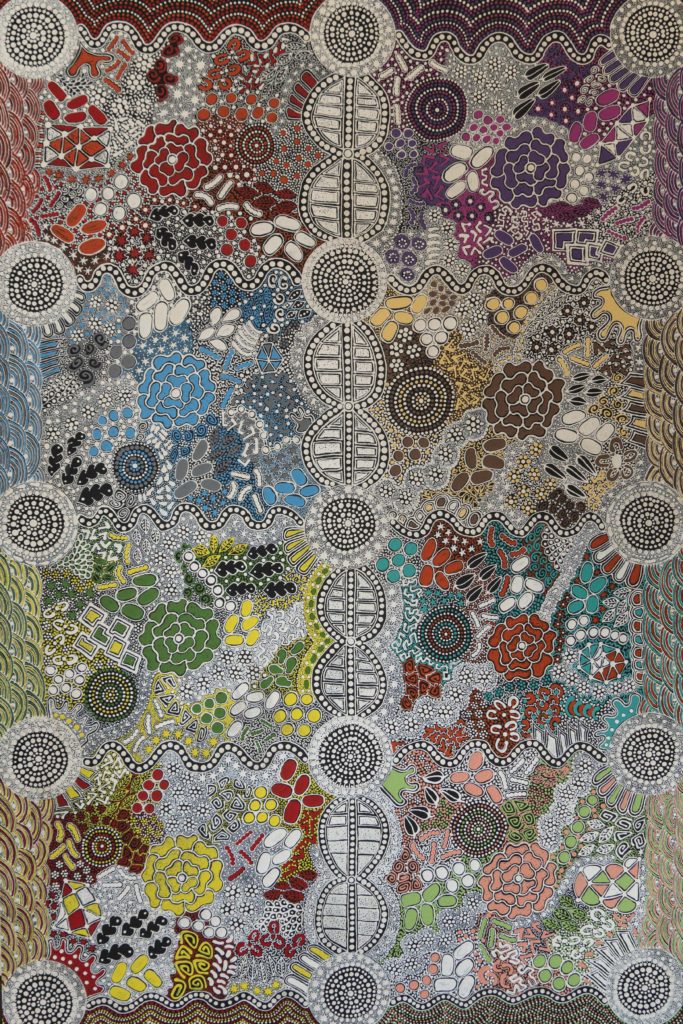
‘Bush Tucker’ by Margaret Wallace.
This year marks twenty years of Reconciliation Australia and almost three decades of Australia’s formal reconciliation process.
Reconciliation is a journey for all Australians – at the heart of this journey are relationships between the broader Australian community and Aboriginal and Torres Strait Islander peoples.
We all have a part to play when it comes to reconciliation, and Grosvenor Place is taking action by building relationships with partners that value Aboriginal and Torres Strait Islander peoples, histories, cultures, and futures.
One such relationship is with Kembla Corp. Kembla Corp is striving to create a business that supports Indigenous jobs and communities. Kembla Corp supply Grosvenor Place with non-toxic, alcohol-free products and in doing so supports Indigenous artists by donating 10% of all sales.
As you pass through the lobby, you will notice the directory board has been updated to include a statement of reconciliation from Grosvenor Place. This statement is displayed against the backdrop of a beautiful artwork that will be updated monthly.
This month’s artwork is Bush Tucker by Margaret Wallace. Margaret was born in 1966 in the famous Aboriginal artist community of Utopia (350km northeast of Alice Springs) in the Northern Territory. Margaret depicts her sacred spirituality entrenched in Utopian culture in the forms of ‘Bush Tucker’.
Through Kembla Corp, Grosvenor Place has commissioned Indigenous artists’ to create vibrant artworks for our soap dispensers:
 |
‘Marrapinti’ by Esther Bruno Nangala Esther Bruno Nangala was born in Alice Springs in 1981. She is a Luritja/Pintupi woman and the granddaughter of Naata Nungurrayi, a legend of the desert art movement. She paints bold traditional designs associated with women’s sites, ceremonies, and the laws of her Country. Her work is vibrant, brightly coloured, and often textured due to the large amount of paint she applies to the linen. |
 |
‘Birds’ by Cindy Nakamarra Gibson Cindy Nakamarra Gibson was born in Alice Springs in 1967 and grew up in Yuendumu. Cindy’s mother, the late Mitjili Napanangka Gibson, and her uncle Pinta Pint Tjapanangka (also deceased) were two of the founding artists of the Papunya Tula Artists. Cindy’s father, Jiti Jiti Tjapurrula (Mickey) was one of the senior traditional owners of the land where the community of Kiwirkurra is established today. Cindy is proud to be painting several designs and techniques that her mother developed. Cindy’s traditional country is centered around Winparky (Mt. Webb) just near Kiwirkurra not far from the South-Western border of Lake Mackay (Wilkinkarra). This painting represents Birds walking around wedged tail eagles. |
 |
‘Bush Yarn’ by Jeannie Mills Pwerle This painting depicts the bush yarn vegetables that grow in the sandy soil of central Australia. The desert yarn appears after rain, producing a pink trumpet-shaped flower and distinctive heart-shaped leaves. The yarns are an important food source in the traditional Anmatyerre and Alyawerre culture of the Utopia region. They are one of the few vegetables that can be found in the arid conditions of central Australia. |

